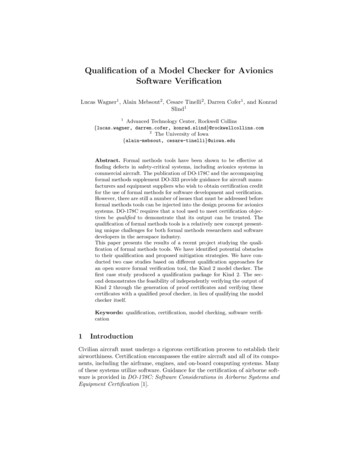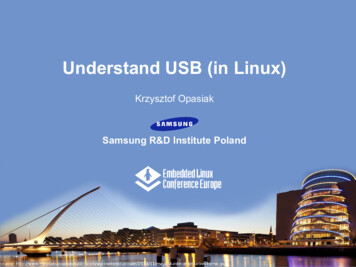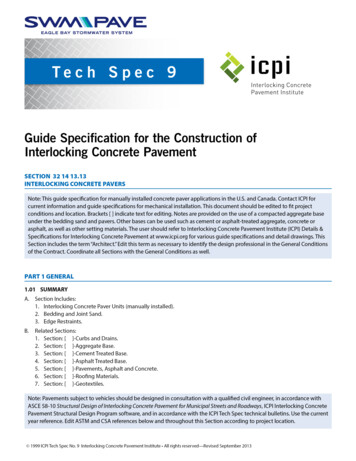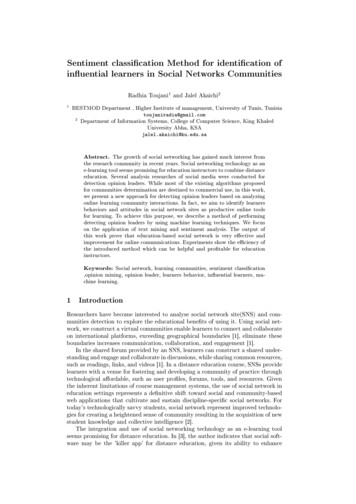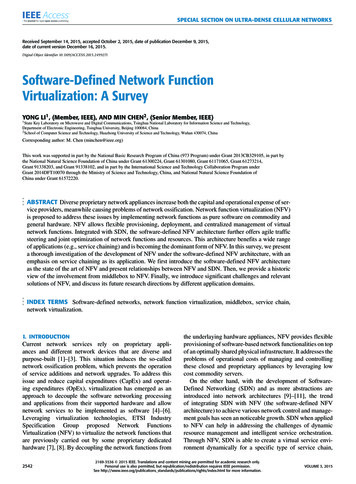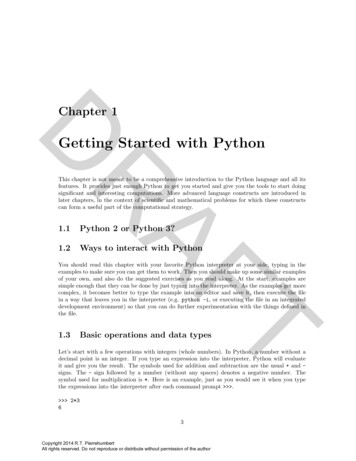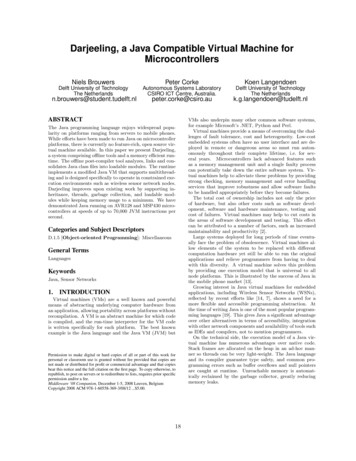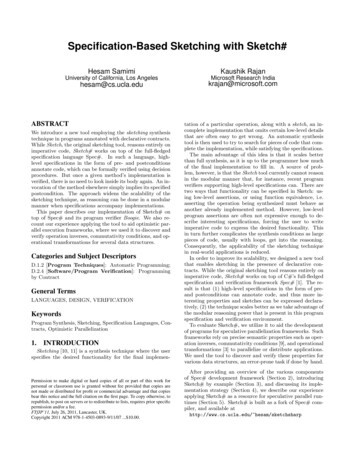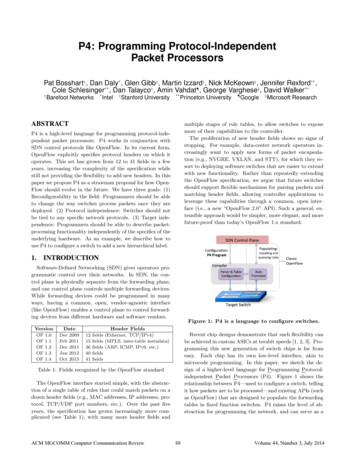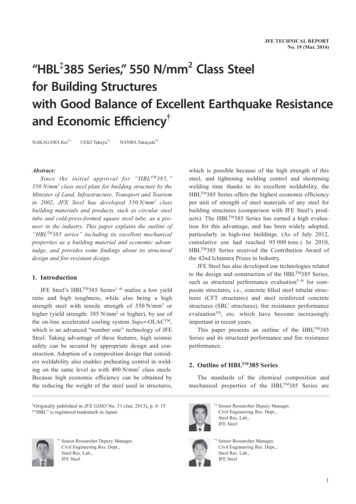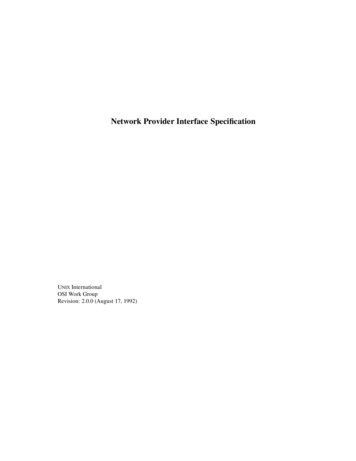
Transcription
Network Provider Interface SpecificationUNIX InternationalOSI Work GroupRevision: 2.0.0 (August 17, 1992)
Published by:UNIX InternationalWaterview Corporate Center20 Waterview BoulevardParsippany, NJ 07054for further information, contact:Vice President of MarketingPhone: 1 201-263-8400Fax: 1 201-263-8401International Offices:UNIX InternationalAsian/Pacific OfficeShinei Bldg. 1FKameidoKoto-ku, Tokyo 136JapanUNIX InternationalAustralian Office22/74 - 76 Monarch St.Cremorne, NSW 2090AustraliaUNIX InternationalEuropean Office25, Avenue de Beaulieu1160 BrusselsBelgiumUNIX InternationalPacific Basin OfficeCintech II75 Science Park DriveSingapore Science ParkSingapore 0511SingaporePhone:(81) 3-3636-1122 Phone:(61) 2-953-7838Fax: (81) 3-3636-1121 Fax: (61) 2 953-3542Phone:(32) 2-672-3700Fax: (32) 2-672-4415Phone:(65) 776-0313Fax: (65) 776-0421Copyright 1992 UNIX International, Inc.Permission to use, copy, modify, and distribute this documentation for any purpose and without fee ishereby granted, provided that the above copyright notice appears in all copies and that both that copyrightnotice and this permission notice appear in supporting documentation, and that the name UNIXInternational not be used in advertising or publicity pertaining to distribution of the software withoutspecific, written prior permission. UNIX International makes no representations about the suitability of thisdocumentation for any purpose. It is provided "as is" without express or implied warranty.UNIX INTERNATIONAL DISCLAIMS ALL WARRANTIES WITH REGARD TO THISDOCUMENTATION, INCLUDING ALL IMPLIED WARRANTIES OF MERCHANTABILITY ANDFITNESS, IN NO EVENT SHALL UNIX INTERNATIONAL BE LIABLE FOR ANY SPECIAL,INDIRECT OR CONSEQUENTIAL DAMAGES OR ANY DAMAGES WHATSOEVER RESULTINGFROM LOSS OF USE, DATA OR PROFITS, WHETHER IN AN ACTION OF CONTRACT,NEGLIGENCE OR OTHER TORTIOUS ACTION, ARISING OUT OF OR IN CONNECTION WITHTHE USE OR PERFORMANCE OF THIS DOCUMENTATION.NOTICE:This document is based on the UNIX System Laboratories Network Provider Interface (NPI) specificationwhich was used with permission by the UNIX International OSI Work Group (UI OSIWG). Participation inthe UI OSIWG is open to UNIX International members and other interested parties. For furtherinformation contact UNIX International at the addresses above.UNIX International is making this documentation available as a reference point for the industry. WhileUNIX International believes that these interfaces are well defined in this release of the document, minorchanges may be made prior to products conforming to the interfaces being made available from UNIXSystem Laboratories or UNIX International members.Trademarks:UNIX is a registered trademark of UNIX System Laboratories in the United States and other countries.Revision: 2.0.0August 17, 1992
OSI Work Group1. IntroductionThis document specifies a STREAMS-based kernel-level instantiation of the ISO/CCITTnetwork service definition. The Network Provider Interface (NPI) enables the user of anetwork layer service to access and use any of a variety of conforming network layerservice providers without specific knowledge of the provider’s protocol. The serviceinterface is designed to support any connection-mode network protocol andconnectionless network protocol. This interface only specifies access to network layerservice providers, and does not address issues concerning network layer management,protocol performance, and performance analysis tools.The specification assumes that the reader is familiar with the OSI reference modelterminology, ISO/CCITT Network Layer Service, and STREAMS.1.1 Related Documentation— 1986 CCITT X.213 Recommendation [1]— ISO 8348 [2]— ISO 8348/AD1 [3]— ISO 8473 [4]— ISO 8208 [5]— ISO 8878 [6]— System V Interface Definition, Issue 2 - Volume 3 [7]1.1.1 RoleThis document specifies an interface that supports the service provided by the NetworkServices Definition for Open Systems Interconnection for CCITT Applications asdescribed in CCITT Recommendation X.213 and ISO 8348 (for CONS) and ISO8348/Addendum 1 (for CLNS). These specifications are targeted for use by developersand testers of protocol modules that require network layer service.Revision: 2.0.0Page 1August 17, 1992
Introduction1.2 Definitions, Acronyms, and AbbreviationsCalling NS userAn NS user that initiates a Network Connection (NC).Called NS UserAn NS user with whom a calling NS user wishes to establish a networkconnection (NC).CLNPConnection-less Network ProtocolCLNSConnection-less Network ServiceCONPConnection Oriented Network ProtocolCONSConnection Oriented Network ServiceDLSAPData Link Service Access PointISOInternational Organization for StandardizationNCNetwork ConnectionNetwork UserKernel level protocol or user level application that is accessing theservices of the network layer.Network ProviderNetwork layer entity/entities that provide/s the services of the networkinterface.NPINetwork Provider InterfaceNSNetwork ServiceNIDUNetwork Interface Data UnitNSAPNetwork Service Access PointNSDUNetwork Service Data UnitOSIOpen Systems InterconnectionQOSQuality of ServiceSTREAMSA communication services development facility first available with UNIXSystem V Release 3Revision: 2.0.0Page 2August 17, 1992
OSI Work Group2. The Network LayerThe Network Layer provides the means to manage the operation of the network. It isresponsible for the routing and management of data exchange between network-userentities.2.1 Model of the NPIThe NPI defines the services provided by the network layer to the network-user at theboundary between the network layer and the network layer user entity. The interfaceconsists of a set of primitives defined as STREAMS messages that provide access to thenetwork layer services, and are transferred between the NS user entity and the NSprovider. These primitives are of two types; ones that originate from the NS user, andothers that originate from the NS provider. The primitives that originate from the NS usermake requests to the NS provider, or respond to an event of the NS provider. Theprimitives that originate from the NS provider are either confirmations of a request or areindications to the NS user that the event has occurred. Figure 1 shows the model of theNPI.Request/ResponsePrimitivesNetwork UserNPINetwork ProviderFigure 1.Indication/ConfirmPrimitivesModel of the NPIThe NPI allows the NS provider to be configured with any network layer user (such asthe OSI Transport Layer) that also conforms to the NPI. A network layer user can alsobe a user program that conforms to the NPI and accesses the NS provider via "putmsg"and "getmsg" system calls.2.2 NPI ServicesThe features of the NPI are defined in terms of the services provided by the NS provider,and the individual primitives that may flow between the NS user and the NS provider.The services supported by the NPI are based on two distinct modes of communication,connection (CONS) and connectionless (CLNS). In addition, the NPI supports servicesfor local management.Revision: 2.0.0Page 3August 17, 1992
IntroductionCONSThe main features of the connection mode communication are:a. It is virtual circuit oriented;b. It provides transfer of data via a pre-established path;c. It provides reliable data transfer.There are three phases to each instance of communication: Connection Establishment;Data Transfer; and Connection Termination. Units of data arrive at their destination inthe same order as they departed their source and the data is protected against duplicationor loss of data units within some specified quality of service.CLNSThe main features of the connectionless mode communication are:a. It is datagram oriented;b. It provides transfer of data in self contained units;c. There is no logical relationship between these units of data;d. It is unreliable.Connectionless mode communication has no separate phases. Each unit of data istransmitted from source to destination independently, appropriate addressing informationis included with each unit of data. As the units of data are transmitted independentlyfrom source to destination, there are, in general, no guarantees of proper sequence andcompleteness of the data stream.Local ManagementThe NPI specifications also define a set of local management functions that apply to bothCONS and CLNS modes of communication. These services have local significance only.Tables 1 and 2 summarizes the NPI service primitives by their state and service.Revision: 2.0.0Page 4August 17, 1992
OSI Work GroupSTATELocal ManagementSERVICEInformation ReportingBindOptions shmentConnection ModeData TransferData MITIVESN INFO REQ, N INFO ACKN ERROR ACKN BIND REQ, N BIND ACK,N UNBIND REQ, N OK ACK,N ERROR ACKN OPTMGMT REQ, N OK ACK,N ERROR ACKN CONN REQ, N CONN IND,N CONN RES, N CONN CON,N TOKEN REQ, N TOKEN ACK,N OK ACK, N ERROR ACKN DATA REQ, N DATA IND,N EXDATA REQ, N EXDATA IND,N DATACK REQ, N DATACK INDN RESET REQ, N RESET IND,N RESET RES, N RESET CONN DISCON REQ, N DISCON IND,N OK ACK, N ERROR ACKTABLE 1. Service Primitives for Connection Mode Data TransferSTATELocal ManagementSERVICEInformation ReportingBindOptions ManagementConnectionless ModeData TransferData TransferPRIMITIVESN INFO REQ, N INFO ACKN ERROR ACKN BIND REQ, N BIND ACK,N UNBIND REQ, N OK ACK,N ERROR ACKN OPTMGMT REQ, N OK ACK,N ERROR ACKN UNITDATA REQ, N UNITDATA INDN UDERROR INDTABLE 2. Service Primitives for Connectionless Mode Data TransferRevision: 2.0.0Page 5August 17, 1992
Revision: 2.0.0Page 6August 17, 1992
OSI Work Group3. NPI Services DefinitionThis section describes the services of the NPI primitives. Time-sequence diagrams thatillustrate the sequence of primitives are included. (Conventions for the time-sequencediagrams are defined in CCITT X.210 [8].) The format of the primitives will be definedlater in this document.3.1 Local Management Services DefinitionThe services defined in this section are outside the scope of the international standards.These services apply to both connection-mode as well as the connection-less modes ofcommunication. They are invoked for the initialization/de-initialization of a streamconnected to the NS provider. They are also used to manage options supported by theNS provider and to report information on the supported parameter values.3.1.1 Network Information Reporting ServiceThis service provides information on the options supported by the NS provider. N INFO REQ : This primitive requests that the NS provider return the values ofall the supported protocol parameters. This request may be invoked during anyphase. N INFO ACK : This primitive is in response to the N INFO REQ primitive andreturns the values of the supported protocol parameters to the NS user.The sequence of primitives for network information management is shown in Figure 2.N INFO REQN INFO ACKFigure 2.Sequence of Primitives: Network Information Reporting Service3.1.2 NS User Bind ServiceThis service allows a network address to be associated with a stream. It allows the NSuser to negotiate the number of connect indications that can remain unacknowledged forRevision: 2.0.0Page 7August 17, 1992
NPI Services Definitionthat NS user (a connect indication is considered unacknowledged while it is awaiting acorresponding connect response or disconnect request from the NS user). This servicealso defines a mechanism that allows a stream (bound to a network address of the NSuser) to be reserved to handle incoming calls only. This stream is referred to as thelistener stream. N BIND REQ : This primitive requests that the NS user be bound to a particularnetwork address, and negotiate the number of allowable outstanding connectindications for that address. N BIND ACK : This primitive is in response to the N BIND REQ primitive andindicates to the user that the specified NS user has been bound to a network address.The sequence of primitives for NS user bind service is shown in Figure 3.N BIND REQN BIND ACKFigure 3.Sequence of Primitives: NS User Bind Service3.1.3 NS User Unbind ServiceThis service allows the NS user to be unbound from a network address. N UNBIND REQ : This primitive requests that the NS user be unbound from thenetwork address that it had previously been bound to.The sequence of primitives for NS user unbind service is shown in Figure 4.Revision: 2.0.0Page 8August 17, 1992
OSI Work GroupN UNBIND REQN OK ACKFigure 4. . . . . .Sequence of Primitives: NS User Unbind & Receipt AcknowledgementServices3.1.4 Receipt Acknowledgement Service N OK ACK : This primitive indicates to the NS user that the previous NS useroriginated primitive was received successfully by the NS provider.An example showing the sequence of primitives for successful receipt acknowledgementis depicted in Figure 4.3.1.5 Options Management ServiceThis service allows the NS user to manage the QOS parameter values associated with theNS provider. N OPTMGMT REQ : This primitive allows the NS user to select default valuesfor QOS parameters within the range supported by the NS provider, and to indicatethe default selection of receipt confirmation.Figure 5 shows the sequence of primitives for network options management.Revision: 2.0.0Page 9August 17, 1992
NPI Services DefinitionN OPTMGMT REQN OK ACK. . . . .Sequence of Primitives: Options Management ServiceFigure 5.3.1.6 Error Acknowledgement Service N ERROR ACK : This primitive indicates to the NS user that a non-fatal error hasoccurred in the last NS user originated request or response primitive (listed in Figure6), on the stream.Figure 6 shows the sequence of primitives for the error management primitive.REQ/RES Primitive **N ERROR ACKFigure 6.Revision: 2.0.0 N BIND REQN UNBIND REQN OPTMGMT REQN CONN REQN CONN RESN DISCON REQSequence of Primitives: Error Acknowledgement ServicePage 10August 17, 1992
OSI Work Group3.2 Connection-Mode Network Services DefinitionThis section describes the required network service primitives that define the CONSinterface.The queue model for CONS is discussed in more detail in CCITT X.213 section 9.2.The queue model represents the operation of a network connection in the abstract by apair of queues linking the two network addresses. There is one queue for each directionof information flow. Each queue represents a flow control function in one direction oftransfer. The ability of a user to add objects to a queue will be determined by thebehavior of the user removing objects from that queue, and the state of the queue. Thepair of queues is considered to be available for each potential NC. Objects that areentered or removed from the queue are either as a result of interactions at the twonetwork addresses, or as the result of NS provider initiatives. A queue is empty until a connect object has been entered and can be returned to thisstate, with loss of its contents, by the NS provider. Objects may be entered into a queue as a result of the actions of the source NS user,subject to control by the NS provider; Objects may also be entered into a queue by the NS provider. Objects are removed from the queue under the control of the receiving NS user. Objects are normally removed under the control of the NS user in the same order asthey were entered except:— if the object is of a type defined to be able to advance ahead of the precedingobject (however, no object is defined to be able to advance ahead of anotherobject of the same type), or— if the following object is defined to be destructive with respect to the precedingobject on the queue. If necessary, the last object on the queue will be deleted toallow a destructive object to be entered - they will therefore always be added tothe queue. For example, "disconnect" objects are defined to be destructive withrespect to all other objects. "Reset" objects are defined to be destructive withrespect to all other objects except "connect", "disconnect", and other "reset"objects.Table 3 shows the ordering relationships among the queue model objects.Revision: 2.0.0Page 11August 17, 1992
NPI Services DefinitionObject XObject YCONNECTNORMAL DATAEXP. NSDUDATA DESDESDESDESDES-AAIndicates that Object X is defined to be able to advance ahead of precedingObject Y.DESIndicates that Object X is defined to be destructive with respect to the precedingObject Y.-Indicates that Object X is neither destructive with respect to Object Y, nor able toadvance ahead of Object Y.N/AIndicates that Object X will not occur in a position succeeding Object Y in a validstate of a queue.TABLE 3. Ordering Relationships Between Queue Model Objects3.2.1 Connection Establishment PhaseA pair of queues is associated with an NC between two network addresses when the NSprovider receives an N CONNECT REQ primitive at one of the network addressesresulting in a connect object being entered into the queue. The queues will remainassociated with the NC until a N DISCON REQ primitive (resulting in a disconnectobject) is either entered or removed from a queue. Similarly, in the queue from thecalled NS user, objects can be entered into the queue only after the connect objectassociated with the N CONN RES has been entered into the queue. Alternatively, thecalled NS user can enter a disconnect object into the queue instead of the connect objectto terminate the NC.The NC establishment procedure will fail if the NS provider is unable to establish an NC,or if the destination NS user is unable to accept the N CONN IND (see NC Releaseprimitive definition).3.2.1.1 User Primitives for Successful Network Connection Establishment N CONN REQ : This primitive requests that the NS provider make a connection tothe specified destination. N CONN RES : This primitive requests that the NS provider accept a previousconnection indication.3.2.1.2 Provider Primitives for Successful Network Connection Establishment N CONN IND : This primitive indicates to the NS user that a connect request hasbeen made by a user at the specified source address.Revision: 2.0.0Page 12August 17, 1992
OSI Work Group N CONN CON : This primitive indicates to the NS user that a connect request hasbeen confirmed on the specified responding address.The sequence of primitives in a successful NC establishment is defined by the timesequence diagram as shown in Figure 7. The sequence of primitives for the NC responsetoken value determination is shown in Figure 8 (procedures for NC response token valuedetermination are discussed in sections 4.1.3 and 4.1.4.).N CONN REQN CONN INDN CONN RES. . .N CONN CONFigure 7. . . .N OK ACKSequence of Primitives: Successful NC EstablishmentN BIND REQ(with TOKEN REQUEST set)N BIND ACK(returns TOKEN value)Figure 8.Revision: 2.0.0Sequence of Primitives: NC Response Token Value DeterminationPage 13August 17, 1992
NPI Services Definition3.2.2 Data Transfer PhaseFlow control on the NC is done by management of the queue capacity, and by allowingobjects of certain types to be inserted to the queues, as shown in Table 4.OBJECT XOBJECT YOctets of NormalDataExpedited DataDataAcknowledgementOCTETS OF sYesNoNoNoNoNoYesThe addition of Object X may prevent further addition of Object Y.NoThe addition of Object X may not prevent the addition of Object Y.TABLE 4. Flow Control Relationships Between Queue Model Objects3.2.2.1 User Primitives for Data Transfer N DATA REQ : This primitive requests that the NS provider transfer the specifieddata. N DATACK REQ : This primitive requests that the NS provider acknowledge thedata that had previously been received with receipt confirmation requested. N EXDATA REQ : This primitive requests that the NS provider transfer thespecified expedited network service data unit.3.2.2.2 Provider Primitives for Data Transfer N DATA IND : This primitive indicates to the NS user that this message containsdata. N DATACK IND : This primitive indicates to the NS user that the remote NS userhas acknowledged the data that had previously been sent with receipt confirmationrequested. N EXDATA IND : This primitive indicates to the NS user that this message unitcontains expedited data.Figure 9 shows the sequence of primitives for successful normal data transfer. Thesequence of primitives may remain incomplete if a N RESET or N DISCON primitiveoccurs.Revision: 2.0.0Page 14August 17, 1992
OSI Work GroupN DATA REQN DATA INDFigure 9.Sequence of Primitives: Data TransferThe sequence of primitives in a successful confirmation of receipt is defined in the timesequence diagram as shown in Figure 10.N DATA REQ(with confirmation request set)N DATA IND(with confirmation request set)N DATACK REQN DATACK INDFigure 10.Sequence of Primitives: Successful Confirmation of ReceiptThe sequence of primitives as shown above may remain incomplete if an N RESET oran N DISCON primitive occurs (see Table 3). A NS user must not issue anN DATACK REQ primitive if no N DATA IND with confirmation request set has beenreceived, or if all such N DATA IND have been previously acknowledged. Following areset procedure (N RESET REQ or N RESET IND), a NS user may not issue aN DATACK REQ to acknowledge an outstanding N DATA IND received before thereset procedure was signaled.Note -- The withholding of confirmation of receipt by a NS user can have an effect onthe attainable throughput on the NC.The sequence of primitives for expedited data transfer is shown in the time sequencediagram in Figure 11. This sequence of primitives may remain incomplete if aRevision: 2.0.0Page 15August 17, 1992
NPI Services DefinitionN RESET or N DISCON primitive is issued.N EXDATA REQN EXDATA INDFigure 11.Sequence of Primitives: Expedited Data Transfer3.2.3 Reset Operation PrimitivesThe reset service is used by the NS user to resynchronize the use of the NC, or by the NSprovider to report detected loss of unrecoverable data.The reset procedure involves the following interactions:A. a N RESET REQ from the NS user, followed by a N RESET CON from the NSprovider; orB. a N RESET IND from the NS provider, followed by a N RESET RES from theNS user.The complete sequence of primitives depends upon the origin/s of the reset action. Thereset service may be:1. invoked by one NS user, leading to interaction (A) with that NS user andinteraction (B) with the peer NS user;2. invoked by both NS users, leading to interaction (A) with both NS users;3. invoked by the NS provider, leading to interaction (B) with both NS users;4. invoked by one NS user and the NS provider, leading to interaction (A) with theoriginating NS user and (B) with the peer NS user.The N RESET REQ acts as a synchronization mark in the flow of N DATA,N EXDATA, and N DATACK primitives transmitted by the issuing NS user; theN RESET IND acts as a synchronization mark in the flow of N DATA, N EXDATA,and N DATACK primitives received by the receiving NS user. Similarly,N RESET RES acts as a synchronization mark in the flow of N DATA, N EXDATA,and N DATACK primitives transmitted by the responding NS user, while theN RESET CON acts as a synchronization mark in the flow of N DATA, N EXDATA,Revision: 2.0.0Page 16August 17, 1992
OSI Work Groupand N DATACK primitives received by the NS user that originally issued the reset. Theresynchronizing properties of the reset service are the following:i. All N DATA, N EXDATA, and N DATACK primitives issued before issuing theN RESET REQ/N RESET RES that have not been delivered to the other NSuser before the N RESET IND/N RESET CON are issued by the NS provider,should be discarded by the NS provider.ii. Any N DATA, N EXDATA, and N DATACK primitives issued after thesynchronization mark will not be delivered to the other NS user before thesynchronization mark is received.3.2.3.1 User Primitives for Reset Operations N RESET REQ : This primitive requests that the NS provider reset the networkconnection. N RESET RES : This primitive indicates to the NS provider that the NS user hasaccepted a reset indication.3.2.3.2 Provider Primitives for Reset Operations N RESET IND : This primitive indicates to the NS user that the networkconnection has been reset. N RESET CON : This primitive indicates to the NS user that the reset request hasbeen confirmed.The sequence of primitives as shown in Figures 12, 13, 14, and 15 may remainincomplete if a N DISCON primitive occurs.N RESET REQN RESET INDN RESET RES. .N RESET CONFigure 12.Revision: 2.0.0. . .N OK ACKSequence of Primitives: NS User Invoked ResetPage 17August 17, 1992
NPI Services DefinitionN RESET REQN RESET REQN RESET CONN RESET CONFigure 13.Sequence of Primitives: Simultaneous NS User Invoked ResetN RESET INDN RESET INDN RESET RESN RESET RESN OK ACKFigure 14.Revision: 2.0.0. . . . . . . . . . .N OK ACKSequence of Primitives: NS Provider Invoked ResetPage 18August 17, 1992
OSI Work GroupN RESET REQN RESET INDN RESET RES. .N RESET CONFigure 15. . .N OK ACKSequence of Primitives: Simultaneous NS User & NS ProviderInvoked Reset3.2.4 Connection Termination PhaseThe NC release procedure is initialized by the insertion of a disconnect object(associated with a N DISCON REQ) into the queue. As shown in Table 3, thedisconnect procedure is destructive with respect to other objects in the queue, andeventually results in the emptying of queues and termination of the NC connection.The sequence of primitives depends on the origin of the release action. The sequencemay be:1. invoked by one NS user, with a request from that NS user leading to an indicationto the other;2. invoked by both NS users, with a request from each of the NS users;3. invoked by the NS provider, with an indication to each of the NS users;4. invoked independently by one NS user and the NS provider, with a request fromthe originating NS user and an indication to the other.3.2.4.1 User Primitives for Connection Termination N DISCON REQ : This primitive requests that the NS provider deny anoutstanding request for a connection or disconnect an existing connection.3.2.4.2 Provider Primitives for Connection Termination N DISCON IND : This primitive indicates to the NS user that either a request forconnection has been denied or an existing connection has been terminated.The sequence of primitives are shown in the time sequence diagrams in Figures 16, 17,18, and 19.Revision: 2.0.0Page 19August 17, 1992
NPI Services DefinitionN DISCON REQ. . .N OK ACK . .Figure 16. . .N DISCON INDSequence of Primitives: NS User Invoked ReleaseN DISCON REQN OK ACKFigure 17.Revision: 2.0.0N DISCON REQ. . . . . . . . . .N OK ACKSequence of Primitives: Simultaneous NS User Invoked ReleasePage 20August 17, 1992
OSI Work GroupN DISCON INDFigure 18.N DISCON INDSequence of Primitives: NS Provider Invoked ReleaseN DISCON REQN OK ACKFigure 19.N DISCON INDSequence of Primitives: Simultaneous NS User & NS ProviderInvoked ReleaseA NS user may reject an NC establishment attempt by issuing a N DISCON REQ. Theoriginator parameter in the N DISCON primitives will indicate NS user invoked release.The sequence of events is shown in Figure 20.Revision: 2.0.0Page 21August 17, 1992
NPI Services DefinitionN CONN REQN CONN INDN DISCON REQ. . . . . .N DISCON INDFigure 20. . N OK ACKSequence of Primitives: NS User Rejection of an NCEstablishment AttemptIf the NS provider is unable to establish an NC, it indicates this to the requester by anN DISCON IND. The originator in this primitive indicates an NS provider invokedrelease. This is shown in Figure 21.N CONN REQN DISCON INDFigure 21.Sequence of Primitives: NS Provider Rejection of an NCEstablishment Attempt3.3 Connectionless Network Services DefinitionThe CLNS allows for the transfer of the NS user data in one or both directionssimultaneously without establishing a network connection. A set of primitives areRevision: 2.0.0Page 22August 17, 1992
OSI Work Groupdefined that carry user data and control information between the NS user and NSprovider entities. The primitives are modeled as requests initiated by the NS user andindications initiated by the NS provider. Indications may be initiated by the NS providerindependently from requests by the NS user.The connectionless network service consists of one phase.3.3.1 User Request Primitives N UNITDATA REQ : This primitive requests that the NS provider send the dataunit to the specified destination.3.3.2 Provider Response Primitives N UNITDATA IND : This primitive indicates to the NS user that a data unit hasbeen received from the specified source address.Figure 22 shows the sequence of primitives for the connectionless mode of data transfer.N UNITDATA REQN UNITDATA INDFigure 22. Sequence of Primitives: Connectionless Data TransferN UDERROR IND : This primitive indicates to the NS user that the data unit withthe specified destination address and QOS parameters produced an error. Thisprimitive is specific to CLNS.Figure 23 shows the sequence of primitives for the CLNS error management primitive.Revision: 2.0.0Page 23August 17, 1992
NPI Services DefinitionN UNITDATA REQN UDERROR INDFigure 23.Revision: 2.0.0Sequence of Primitives: CLNS Error Indication ServicePage 24August 17, 1992
OSI Work Group4. NPI PrimitivesThis section describes the format and parameters of the NPI primitives (Appendix Ashows the mapping of the NPI primitives to the primitives defined in ISO 8348 andCCITT X.213). In addition, it discusses the states the primitive is valid in, the resultingstate, and the acknowledgement that the primitive expects. (The state/event tables forthese primitives are shown in Appendix B. The precedence tables for the NPI primitivesare shown in Appendix C.) Rules for OSI conformance are described in Addendum 1 tothis document.Tables 5, 6, and 7 provide a summary of the NS primitives and their ntN CONN
The Network Layer provides the means to manage the operation of the network. It is responsible for the routing and management of data exchange between network-user entities. 2.1 Model of the NPI The NPI defines the services provided by the network layer to the network-userat the boundary between the network layer and the network layer user entity.
